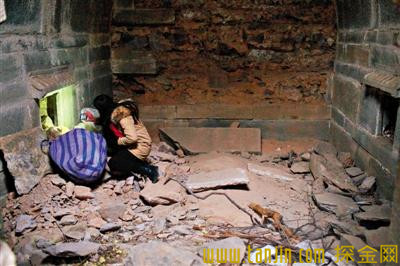
Yesterday, the reporter discovered quilts, lunch boxes, etc. in the ancient tomb suspected to be the Liao and Jin period, and was suspected of being left behind by the tomb robbers. Officials claim that the tombs here are not cultural relics.
Recently, archaeological enthusiasts discovered that a burial tomb in the foothills of the Shuangquan Temple in the Black Stone Township of Shijingshan District is now a new cavern, which leads directly to the underground palace. It is understood that the tombs here have the characteristics of the eunuchs and tombs of the Liao and Jin Dynasties. The owner of the tomb was suspected to be eunuchs at that time. According to the relevant staff of the Shijingshan District Cultural Affairs Committee, the tomb was stolen before liberation. There were no names and no records, and it was not a cultural relic.
Ground stone brick suspected of Liao Jingou pattern brick
This burial tomb is located in the northeastern Shuangquan Temple in the Black Stone Township of Shijingshan District and on a half hill named Cuiwei Mountain. The basic shape of the entire tomb is the front and back circles, backed by Cuiwei Mountain facing south, and the tombs are higher on the north side. The stones stack up to about 56 meters high and the south side is less than half a meter high.
Outside the tomb, there are six burglar caves. The burgeoning caves on the western side of the tomb are digging about two to three meters deep. One person is wide, and there are no samps in the three tombs. The easternmost tombs were dug into the underground palace, and the damage was severe. The bricks and stones on the underground palace were stolen. In the underground palace, there were two stolen holes that continued to dig down.
In the three tombs, the most middle ground palace is relatively intact. It can enter the underground palace through a burglary and is about two meters long. It has a stone carving formed at the main entrance of the ground palace. There are square stone frames resembling windows on the two walls of the ground palace and carved with stone carvings. . In the stone frame, there are also stolen holes that extend downwards.
Mr. Wu, an archaeologist who discovered that there were new burglars in the tombs here, said that the stone bricks in the tombs were rarely seen. It should be a groove brick in the Liao and Jin Dynasties.
Remaining quilt boxes in ancient tombs
Shuangquan Temple staff said that the area is said to be the tomb of the eunuchs, including the piers of the horses next to the tombs, and should all be cultural relics.
In addition, the staff member stated that the tombs had been stolen before long ago, but in the spring of last year, there were new tombs. "Although it is still a few holes, the tombs are estimated to have been dug inside again. It is estimated that everything is gone. The lunch boxes and other things are estimated to have been lost by the tomb robbers."
In the middle of the tombs of the tombs, stones were scattered on the ground, leaving a blue-and-white striped nylon belt with quilts filled with dust. At the entrance to the underground palace, seven or eight white plastic lunch boxes were left.
Near Shuangquan Temple, a middle-aged man with a arm guard wearing a “forest ranger†also claimed that this was a tomb of the eunuchs and was stolen several times. “But we are only responsible for forest fire prevention, regardless of the tomb.â€
Yesterday, the staff of the Shijingshan District Cultural Commission stated that the tombs were stolen before the liberation and that there were no owners or names and they were not cultural relics.
â– Follow up
The burial suspects as superior to inferior relationship
Mr. Wu, who has been exploring ancient tombs in the countryside all the year round, stated that in 2002, he visited the tombs on the ground.
For the age to which the ancient tomb belonged, Mr. Wu said that from the perspective of the westernmost tombs, it should be the tombs of the Ming Dynasty. Because the pattern of the tombs of eunuchs in the Ming Dynasty was relatively uniform, the underground palace was generally a hairline type, the underground was a trampoline, the underground palace was facing a Buddhist shrine, and there were other shrines on both sides. The characteristics of the tombs were more consistent. However, from the middle of the tombs with better preserved tombs, the lining of the Liao and Jin Dynasties was affixed to the inner wall. It should be the tombs of the Liao and Jin Dynasties.
"Comprehensively, the three tombs may be the eunuch relationship between the superior and the inferior." He analyzed that the tombs in the middle should be the largest and the first to be buried. On both sides is likely to be the man of the eunuch, buried in the dynasty after the Liao Dynasty.